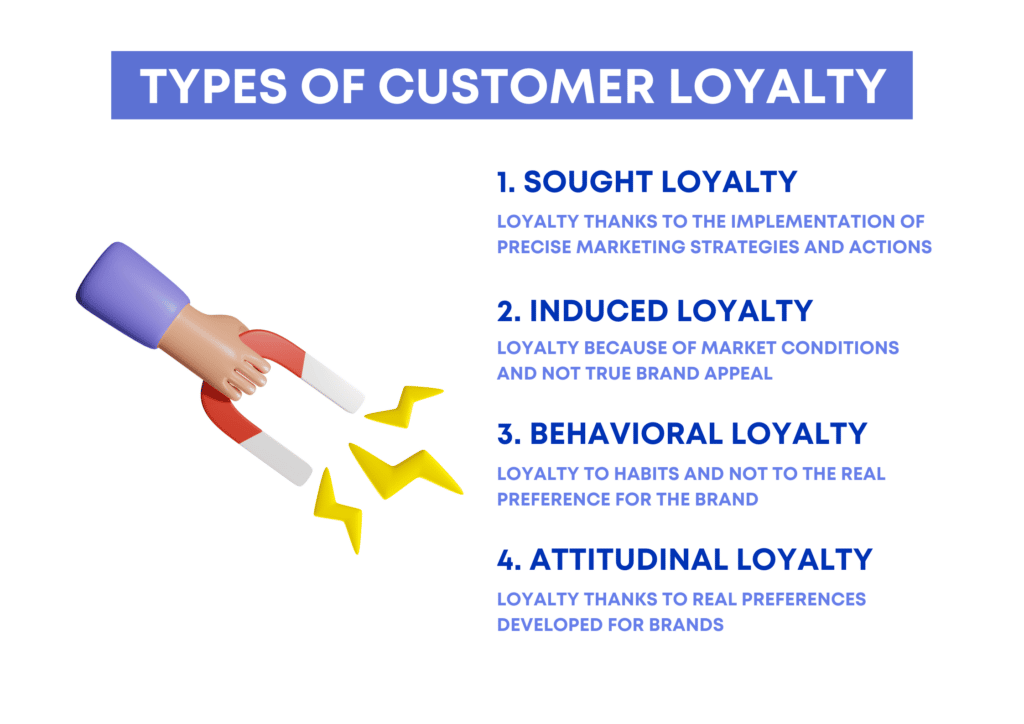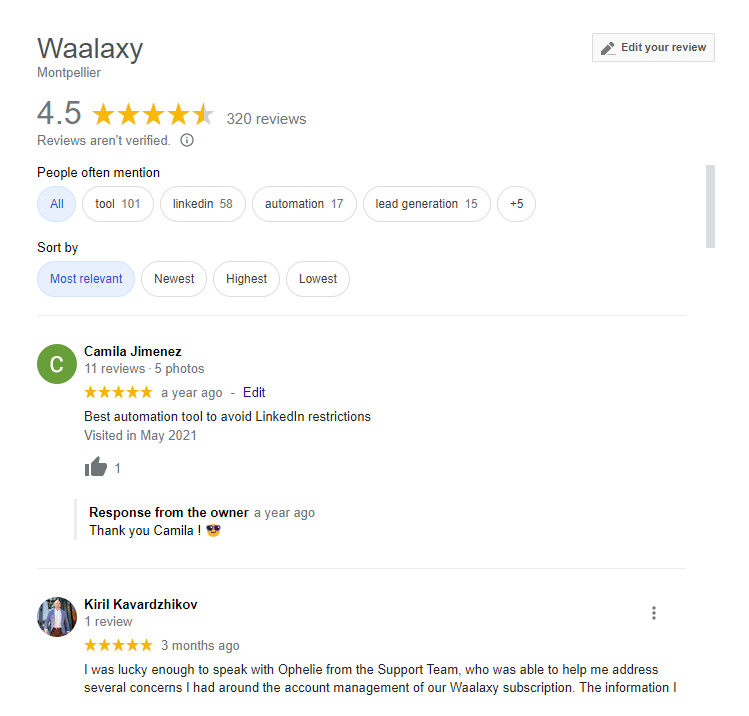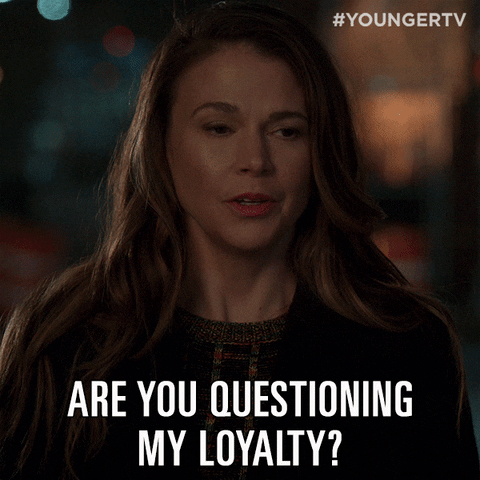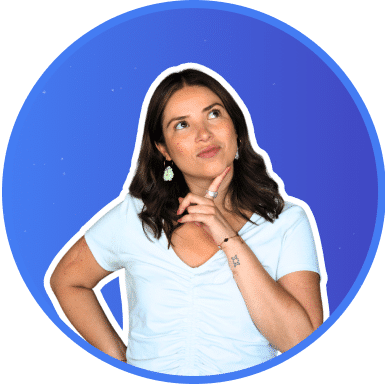Indeed, customers may decide to buy a product from another company by doing a quick search on the internet. For this reason, the challenges of customer loyalty are unavoidable. 👌
Markets are becoming more and more diverse, and products and services are constantly expanding, so retaining customers is becoming increasingly difficult. 🙈
Read this guide to find out more!
What is true Customer Loyalty? Meaning
Generally speaking, customer loyalty is when a consumer repeat a purchase of a product or service in favor of the same business. Being a loyal customer of a brand therefore means considering it part of your spend habits and emotional connection to it. 🥰
Lifetime loyalty therefore includes the actions taken to earn customers. In marketing terms, loyalty also has implications in the field of client relations. When a brand consistently implements a customer loyalty strategy, the aim is to persuade the customer to make another purchase or renew their shop subscription in the long or short term (week). 🧲
Customer loyalty is essential to boost your business. 🚀 When you’re trying to grow your business, it’s easy to focus too much on attracting new customers with a deal and forget about keeping existing customers happy, i.e. doing “lead nurturing”.
That’s why client retention is just as important as customer acquisition. If you don’t, you give the impression that you’re not interested in the customers who buy your product. 👀
Typically, it’s all about balancing customer acquisition and retention to accelerate growth and optimize your company’s performance.
How to Build your Customer Loyalty?
Loyalty or fidelity often has a positive connotation and is generally defined as the conscious or unconscious selection process (evaluation and decision) that the client makes, when they have a preference for your brand. 💫
The term “customer loyalty” refers to all activities and strategies aimed at persuading customers to continue buying your product or service rather than competing with it. 🤫 It’s a process of building ongoing customer loyalty.
Loyalty activity begins when a prospect first interacts with your company and continues throughout the client relationship.
When a customer leaves your company to find another competitor, we call it churn. It means “losing customers”. 😥 Therefore, the aim of effective sales strategies is to avoid losing customers and encourage existing customers to make new purchases!
However, loyalty, depending on the context, can result from persistent loyalty, passive behavior or genuine new purchase decisions in favor of the brand. Let’s take the example of a subscription activity, such as a gym membership, or a specific service with commitment (software, internet box, etc.).
The reason for this is tacit renewal of the contract, or the customer’s inertia due to the cost of cancelling.
There are different types of customer loyalty: 👇
What are the 4 Types of Customer Loyalty?
-
1. Desired customer loyalty :
Sought loyalty is loyalty behavior that customers reflect through the implementation of specific strategies and actions 🎯 (such as loyalty programs, the implementation of solutions to manage client personalizations, customer-centric approaches, etc.).
-
2. Induced customer loyalty:
Induced loyalty is a state of brand loyalty where consumers suffer from market conditions (monopoly, barriers to exit, exclusivity of offer, etc.) rather than true brand appeal. 😑
-
3. Behavioral customer loyalty:
This is due to the inertia of behaviors and habits, not the result of genuine brand preference. 😦 This is often due to practicality.
💡 Customers may remain loyal to the point of sale because it’s part of their daily routine, for example.
-
4. Attitudinal loyalty
Describes loyalty behaviors, or repurchases, that correspond to preferences developed in the real world for brands. The various factors that can drive attitudinal loyalty, or “Attitudinal Loyalty”, are generally: ⏬
- product quality,
- price,
- the quality of the customer experience or purchasing,
- quality of client relations.
Loyalty therefore has its own attitude, and is very often the result of loyalty demanded.
👉 The existence of these different forms of customer loyalty shows that the relationship between client satisfaction and loyalty is much more complex than we think.
Satisfaction is certainly a lever for loyalty, but there are also “dissatisfied loyal consumers”. Moreover, consumers are rarely totally satisfied and totally loyal to a brand. 🫶

Stakes of Building Loyal Customers
-
For your e-reputation:
For companies, building customer loyalty means more than just increasing sales. Nurturing the digital marketing relationship between customers and companies also means ensuring that they maintain the company’s e-reputation thanks to client recommendations, a key factor in the success of today’s businesses. 🌐
Did you know that satisfied customers talk about their positive experiences with an average of 3 people? 🗣️ Conversely, dissatisfied customers share a negative experience with 10 people… Customer satisfaction is not only important for online reputation, but also offline, thanks to word-of-mouth.
-
For your brand:
Customer loyalty enables you to retain acquired customers, but paradoxically, it also facilitates the acquisition of new customers. 💎 In fact, when customers turn their backs on your product or service, you run the risk of them leaving a negative review of your business online.
On the other hand, potential customers feel comfortable when they are satisfied and rate your company positively. In this way, new customers are much more likely to buy one of your products.
-
On collecting reviews:
Customer reviews should be collected, as there is a strong correlation between customer loyalty and reviews on the Internet. ✍️ On the contrary, rather than ignoring or fearing customer reviews on the Internet, the publication of client reviews should be encouraged and taken into account in sales strategy.
The more we have, the more content we can collect and analyze.
It’s an opportunity for your company to improve its products and services. 👌 In fact, analyzing reviews can help you learn more about average satisfaction and service weaknesses.
What’s more, the more relevant and constructive information you get from your customers, the easier it will be to create a marketing plan to increase your company’s sales.

-
Your visibility:
Finally, customer reviews guarantee increased visibility on the Internet. 🔍
Google’s search enginealgorithm takes into account a company’s average rating. So if you have few reviews or lots of negative ones, your online visibility can drop considerably.
As a result, you can use strategies tailored to e-reputation and client loyalty, to gain visibility on all your communication platforms.
What are the Benefits of Customer Loyalty Marketing?
Implementing a customer loyalty strategy presents an opportunity to improve a company’s competitiveness on several levels. Secondly, if the strategy is used effectively, sales will increase considerably. 💥
Customer loyalty is crucial to your company’s long-term growth. Customers who buy from you know your business, making it easier to forecast future profits. 💹
They’re not one-off customers, because they buy regularly and consciously. By selling quality at the right price combined with excellent customer service, you already have the magic formula!
In other words, your company has already established a relationship of trust with these customers. A successful customer loyalty strategy has a direct impact on the customer lifecycle within the company.
When customer acquisition efforts result in a steady loss of existing customers, company growth can slow down or come to a halt.
Conversely, maintaining a customer base steadily increases the customer base, sales and profitability.
1. Economic benefits of customer loyalty
Firstly, customer loyalty can result in significant cost savings. In fact, the cost of retaining an existing customer is one-sixth the cost of finding a new one. 🤑
The effectiveness of the strategy allows these economic and human resources, to be better used in other more useful projects or processes!
2. Limiting attrition
The attrition rate, or “churn ” in English, is a reference to the number of customers you lose on a monthly or annual basis. Unfortunately, no company can avoid losing customers, and no company is 100% capable of keeping them either.
Calculating this rate is very simple:
- Step 1: Divide the number of customers lost over a given period by the total number of customers.
- Step 2: Multiply this number by 100 and you’ll know your churn rate.
- Step 3: This customer erosion can be limited by retaining the company’s existing customers.
3. Get committed customers
Finally, loyal customers are also an opportunity to have a brand ambassador. 🤩 Assuming your loyal customers are happy with your service, they’ll try to spread the word to those around them.
For example, in social networks and forums, between satisfied and dissatisfied customers, they may defend your company. In this way, loyal customers become powerful allies in your e-reputation. It’s an excellent form of passive influence for you!
4. Impact on sales
Ultimately, the impact on a company’s bottom line can’t be ignored. On average, a company that retains 5% of its customers will see its sales increase by 25% to 55%. Building good customer relationships is therefore a successful medium- and long-term strategy. ⚒️

How to Measure and Increase Customer Loyalty?
Customer service management must become a priority, thanks to effective strategies and KPIs that must be implemented. In practice, some important performance indicators are recognized as benchmarks. 📊
A customer loyalty strategy can save a company a ton of money. 🪙 According to several studies, it costs 6 to 7 times more to acquire a new customer than to retain an existing one.
These figures are due to the fact that existing customers have already had a positive experience with your company, they know it, they like it and they trust it. 🥰
In return, you certainly know their needs and preferences, so they’re much more responsive to your sales offers. For existing customers, you can easily maintain relationships with a minimum of marketing effort and cost.
What’s more, these customers are an excellent source of referrals and leads to help you grow your business.
Qualified leads are existing customers who have recommended a product or service with which they are already satisfied, so they have the advantage of being easier to convert. 😏
Existing customers are a great source of informational capital, enabling companies to continually improve their offerings and stay competitive in the marketplace.
Selling to your existing customers also protects your profit margins. These customers are less concerned about price, knowing that they are already convinced of the superior quality of your product.
1. Satisfaction survey
To examine the measures most relevant to your work, you need to address the issue of satisfaction surveys. 📞
This is an ideal way of finding out more about your customers’ satisfaction by gathering feedback on your services and products. This should be the basis for all your efforts, as it enables you to regularly monitor trends in customer satisfaction.
2. Customer Satisfaction Score
The CSAT or “Customer Satisfaction Score” is a classic customer satisfaction survey. 👂
It’s efficient and gives a complete picture of customer satisfaction at all times. In surveys, it is expressed by questions like “Are you satisfied with…?”. To use CSATs, you’ll need to choose from among the most common types of evaluation, such as rating from 1 to 10, or YES/NO answers.
3. Net Promoter Score
The NPS or “Net Promoter Score” is particularly interesting from the point of view of customer loyalty. It takes the form of questions such as “Are you likely to recommend our services/products to others?
This will show you how much customers in their personal circle of friends or colleagues might appreciate the quality of your service. 😁
It’s important to know that this decision to speak positively about your product correlates with customer loyalty.

4. Purchase rate
This rate represents the percentage of customers who buy again, after having made their first purchase. 🫰
This rate shows your ability to retain customers and bring them back to your company. It should be noted that the implementation of this indicator requires the ability to track the progress of a customer’s purchase, for example via a loyalty card or points accumulation system.
5. Upsell rate
This rate is very similar to the purchase rate, as it allows us to know the percentage of customers who have recently purchased a different product from the previous one. 🤔
This notion is interesting, because if a customer is likely to buy another product or service from you, it’s because they have confidence in the quality of your initial product or service.
6. Loyalty rate
You can calculate your loyalty rate by taking the average of the last three rates above, NPS, Purchase Rate and Upsell Rate. 🧮
To do this, you need to ask 3 different questions from 1 to 10. “What is the probability that you will make a new purchase?” “Are you considering testing new products or services?” “Would you recommend our brand to your family, friends or colleagues?”.
Each of these questions will give you a score out of 10. Then you need to average these three scores to get the overall loyalty rate – get your calculators! 🤣
👉 In addition, ask yourself what indicators are you already using?
Different analyses of your customer base may use all, or some, of these indicators. There are no rules, because it all depends on your company and your industry.
Based on your current needs, you can create a satisfaction survey that contains the metrics you consider most relevant for gaining insights to solve your specific problem. 😉
💡 Calculating the customer retention rate:
Conclusion: What is Customer Loyalty in Business?
In this article, we’ve shared some valuable tips you can implement to build customer loyalty. 💘 However, there are a few important points to note:
- First and foremost, high-quality customer service and excellent products are the foundation of successful customer loyalty. But this is not enough. Building customer loyalty requires going one step further and implementing real loyalty strategies and a concrete prospecting plan.
- Personalize customer relations: To build a relationship of trust over the long term, you need to establish a strategy upstream. Customers need to feel valuable and unique from their very first experience and contact with your brand. 😘
Similarly, when communicating with you, it’s important to know your customers: customers remain loyal to your brand when they feel taken into account, they need fast support and to get the right answers.
💡 Save time, make your team more efficient and build customer loyalty by choosing a customer relationship management solution that gives you all the information about your customers at a glance, thanks to Waalaxy CRM :
Discover Waalaxy 🪐In short, the key to successful loyalty is to treat every customer well 👑 (the big ones, as well as the little ones)!
Encourage customer loyalty and voice: Today, consumers have an average of 14 loyalty cards. 😅 So brands don’t hesitate to reward their customers’ loyalty by awarding points offering discounts, gifts or even access to additional services.
What’s more, customers like to interact freely with the company and other customers. 👋 Creating a community of customers around your brand enables greater engagement and a sense of belonging to your brand.
FAQ: Customer Loyalty Program
Why Customer Loyalty is important?
Building customer loyalty is a major concern for companies of all sizes in all industries. 🧨 Because it contributes to the sustainability of your business, it is known that it is difficult to attract new customers in the long term, so keeping your current customers is cheaper than finding new ones.
The goal of customer retention is to maintain lasting relationships with customers, building trust. You this you must: 👇
- Provide offers that are easy to understand,
- Be your best advertisement (build word of mouth),
- Increase your company’s profits,
- Improve your image,
- Strengthen customer loyalty,
- Become more competitive.
👉 Customer loyalty is characterized by repeated purchases of products or services from the same brand or company. 💰 This reflects not only a buyer’s conscious or unconscious preference over a competitor’s offering, but also their attachment to your brand.
Customer retention is more than just a loyalty program, it’s about building lasting relationships with customers across multiple acquisition channels.
A successful loyalty process has many positive effects!
What are other Synonyms for Customer Loyalty?
You can simply say “Customer Loyalty”, or you can use other synonyms of this term like “Loyalty of customers”, “Loyalty of clients”, “Retaining customers”, “Build customer loyalty”, etc. 😎

There you go, ✨ now you know how to make your customer loyalty strategy successful!












